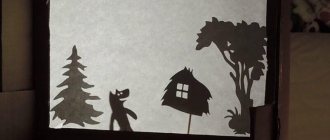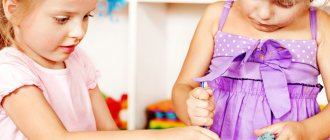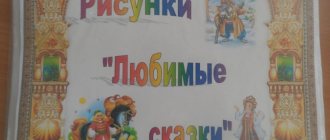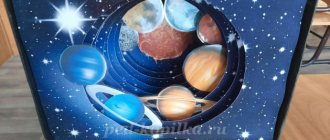Creative project to create the artistic and aesthetic development of children “Shadow Theater”
author:
Vinyukova Irina Viktorovna
Teacher of MBDOU Kindergarten No. 42 "Malinka" Stary Oskol, Belgorod region
Bozhkova Svetlana Vladimirovna
Teacher of MBDOU Kindergarten No. 42 "Malinka" Stary Oskol, Belgorod region
Creative project to create the artistic and aesthetic development of children “Shadow Theater”
Creative project to create artistic and aesthetic development of children
"Shadow play"
Completed:
Vinyukova I.V.
Bozhkova S.V.
Brief summary of the project:
Artistic and aesthetic development" involves the development of prerequisites for the value-semantic perception and understanding of works of art and the natural world:
- the formation of an aesthetic attitude towards the surrounding world;
- formation of elementary ideas about types of art;
- perception of music, fiction, folklore;
- stimulating empathy for characters in works of art;
- implementation of independent creative activities of children (visual, constructive-model, musical, etc.).
).
Artistic and aesthetic activity is an activity specific to children, in which a child can most fully reveal himself, his capabilities, feel the product of his activity (drawings, crafts) and, in a word, realize himself as a creative person.
The main goal of the teaching staff of the preschool educational institution is to develop the child’s creative potential and create conditions for his self-realization.
To obtain the expected results, a system of work on artistic and aesthetic education has been created in a preschool institution, which consists of interconnected components:
- updating the content of education (choice of programs and technologies);
- creation of conditions for aesthetic education (staffing, educational and methodological support, creation of a subject-development environment);
- organization of the educational process (work with children and parents);
- coordination of work with other institutions and organizations.
This system of work involves close cooperation between the young teacher and all preschool specialists (psychologist, music director, visual arts teacher, psychologist, kindergarten head, senior teacher, teacher-mentor).
Each employee assumes certain functional responsibilities in the field of artistic and aesthetic education. Purposeful and coordinated activities of all specialists are achieved through joint planning of the educational process.
Children's shadow theater is not just a type of game for a child - it is an additional way of his development. Playing with shadows stimulates the baby's imagination and develops his imagination. Obtaining certain characters here is possible, for example, by folding your fingers in a certain way. Accordingly, this provides additional opportunities for developing the child’s manual dexterity and coordination of his movements. At the same time, if we are talking about an early age, then the performance can be organized by the child’s parents.
Older children are already able to take part in the performance themselves. For group activities it is also possible to use a shadow theater. In kindergarten, these entertainments are often used as exercises to develop the child’s motor skills and speech. And text accompaniment, in turn, stimulates the speech culture of children.
Project type:
creative, long-term, group.
Project participants:
children of the younger group and their parents; educators.
Project implementation timeline:
May 2021 to May 2021.
Relevance:
One of the most effective means of developing and educating a child in early preschool age is theater and theatrical games, because Game is the leading type of activity for preschool children. And theater is one of the most democratic and accessible forms of art, which makes it possible to solve many pressing problems of pedagogy and psychology related to artistic and moral education, the development of personal communicative qualities, the development of speech, imagination, fantasy, initiative, etc.
Children learn to notice interesting ideas in the world around them, embody them, create their own artistic image of a character, they develop creative imagination, associative thinking, and the ability to see unusual moments in the ordinary.
This activity develops the child’s personality, instills a sustainable interest in literature, music, theater, improves the skill of embodying certain experiences in play, encourages the creation of new images, and encourages thinking. Theater is one of the most democratic and accessible forms of art for children; it allows solving many pressing problems of modern pedagogy and psychology.
In addition, collective theatrical activities are aimed at a holistic impact on the child’s personality, his emancipation, involvement in action, while activating all his capabilities; for independent creativity; development of all leading mental processes; promotes self-knowledge and self-expression of the individual with a fairly high degree of freedom.
Objective of the project:
To create conditions for self-realization of a young teacher in the field of artistic and aesthetic development of children.
Tasks:
- to develop children’s interest in theatrical and play activities;
- introduce a new type of theater - shadow;
- develop artistry and communication.
Project implementation forms:
- reading children's fairy tales;
- looking at illustrations for fairy tales;
- didactic games;
- entertainment (shadow theater games);
- conversations.
Expected results of the project:
In the course of implementing the tasks of raising and developing theatrical activities in a child, it is assumed that children will acquire:
- the required minimum knowledge of fairy tales;
- desire to read new fairy tales;
- will learn to find their reflection and ideas about the world around them and their attitude to a particular problem situation;
- master shadow theater skills;
- will develop creative potential.
Brief description of the project by stages.
Theater activities:
didactic games, games in various types of theater, performances of fairy tales using plane figures, entertainment “Seasons”.
Reading fiction:
reading children's folk tales, reading children's original fairy tales
Socialization:
conversations about types of theater, conversations on the topics: “Who is an actor”, “Who is a make-up artist”, “Who is a decorator”, looking at illustrations for fairy tales, watching videos of shadow theater
Cognition:
didactic games “Count the shadows”, “Find a larger or smaller shadow”, “Find a narrower or wider shadow”, “Find a similar shadow”.
Ecological development - looking at shadows while walking. Didactic games: “Find the shadow of a tree or bush”, “Create your own shadow”. Conversations: “Is there shadow on a cloudy day”, “Is there shadow in winter”...
Experiments: “Make a shadow from a twig, a shovel, a bucket...”
Communication:
replenish children's vocabulary with vocabulary related to the art of theater, retelling fairy tales, telling fairy tales by role, telling fairy tales of one's own composition.
Artistic creativity:
drawing shadows (shading on stencils with black or a simple pencil), coloring books based on fairy tales.
Music:
listening to music for fairy tales, playing musical instruments during performances of fairy tales.
Physical development:
improve children's skills in creating images of wildlife using their hands for shadow theater.
Working with parents:
article for parents in the group newspaper “The role of theatrical activities in the development of preschool children.” An article for parents in a group newspaper: “Chinese Shadow Theater.” An article for parents in a group newspaper: “Home shadow theater.” Replenishment by parents of the material base for theatrical activities in the group. Parents replenish the library with fairy tales in the group. Participation of parents in the production of various planar figures together with children for playing them in a shadow theater
Group work:
production of a set of planar figures for showing various fairy tales in a shadow theater, production of didactic games.
Stages and activities of the project implementation.
- stage. Preliminary work:
- selection of literature, paintings, illustrations, preparation of presentations;
- replenishment of the theater corner;
- announcement to children and parents about the start of the project;
- creating a high-quality subject-development environment to expand children's understanding of the theater, its types, attributes, costumes, and scenery.
- stage. Project implementation:
| Joint educational activities | Organization of the environment | Working with parents | |
| Cognitive development | Conversation « Fairy-tale heroes" ; « Favorite fairy tales"; “Do children like puppet theater?” “What is theater?” Looking at illustrations for fairy tales. Problem situation “Why is the bun round?”, “What would happen if the bun turned out to be square?” D/s based on fairy tales: “Who is hiding in a fairy tale?”, “Find out by the contour”, “Who is behind whom?”, “Find a couple”, What (who) is missing?”, “Find the artist’s mistakes”, “From which fairy tales?". Puzzles based on fairy tales, games with cubes “Assemble a fairy tale.” Experimentation: What can you make an egg out of so that it doesn’t break like in a fairy tale? (natural egg, shell, clay, plasticine, paper, wood......). Design: house for the heroes of the fairy tale “Teremok”. Hide seven kids behind a high fence. Let's help the piglets build houses. | Plot pictures, illustrations for fairy tales. Tabletop theaters: “Turnip”, “Ryaba Hen”, “Teremok”; theater on flannelgraph: “Zayushkina’s hut”, “Kolobok”. Replenishing the experimentation corner with materials for the experiment (natural egg, shell, clay, plasticine, paper, wood......). | Invite parents to take part in the creation of the mini-museum “Teddy Bear”. Oral survey “Do you play theater with your child” (at the beginning and end of the project). |
| Social-communicative development | Communication activities : a game that imitates the images of well-known fairy-tale characters (a clumsy bear walks towards the house, a brave cockerel walks along the path). A single-theme dramatization game with several characters based on folk tales (“Kolobok”, “Turnip”) and author’s texts (V. Suteev “Under the Mushroom”, K. Chukovsky “Chicken”). Mimic gymnastics “Show your mood if.....”. The game is a dramatization of “Teremok”. C/i: “Hairdressing salon (dressing room)”; "Let's go to the theater." Self-service and basic household work: game situation “Mishutka doesn’t know how to hold a spoon”, Help the artists put things in order in the costume room. | Mini stage with microphone. Rubber Toy Theater, costumes for the fairy tale “Turnip”, “Teremok”. | Individual conversations, consultations with parents to identify their interest in replenishing the theater corner, their abilities in one or another area of handicrafts and opportunities. |
| Speech development | Modeling fairy tales using mnemonic tables. Voice imitation games: “Who screams?”, “Who gives their voice?” ... Learning tongue twisters. “One, two, three repeat” D/i Wonderful bag (heroes of which fairy tales) Role-playing dialogue heroes of fairy tales (“Rukavichka”, “Zayushkina’s hut”). R/i “Say a word.” Reading fiction: from quiet A. Barto “Toys”. P. Voronko “New clothes”. L. Tolstoy “Three Bears”, “Grandfather sat down to drink tea”. Russian folk tales “Kolobok”, “Mitten”, “Winged, shaggy and oily”, “Golden comb cockerel”. | Flannelograph. Creation of mnemonic tables. Fairy tales stories on the topic. | Memo “Games for the development of speech of children 3-4 years old. Recommend that parents read Russian folk tales at home with their children. |
| Artistic and aesthetic development | Visual activities: applique “Turnip”, “Let’s decorate Mashenka’s dress” (cone theater, applique on cones). Coloring pictures based on Russian folk tales. Drawing "Kolobok is rolling along the path" Modeling from salt dough “Pies for grandparents”, “Kolobok”. | Coloring pages based on the fairy tales “Teremok”, “Kolobok”, “Turnip”, “Ryaba Hen”. Salt dough of different colors. Molds for making pies. | Joint creativity with parents “My favorite fairy-tale hero”, “Animals in fairy tales”. |
| Physical development | Outdoor games with a plot: “At the Bear in the Forest”, “Shaggy Dog”, “Sparrows and the Cat”, “The Little White Bunny Is Sitting”, “Who Runs Faster to the Named Hero of the Fairy Tale”. Imitation exercises “Depict the hero of a fairy tale”, “Show how a bear, a fox walks...” | Masks for outdoor games. | Invite parents to make their own masks |
Stage 3. Presentation:
children show their parents a dramatization of the fairy tale “Teremok”. Organization of the mini-museum “Teddy Bear”.
Project results.
The maximum possible conditions have been created for the self-realization of a young teacher in the field of artistic and aesthetic development of children. Professional interest in educational activities with children has increased. The competent level in implementing assigned tasks in working with children has increased. The mechanism for the professional growth of a young specialist has been fully launched.
The children developed an interest in theatrical activities and a desire to participate in all theatrical events.
Children's verbal communication skills have improved. They began to emotionally read poetry and convey the image of heroes in fairy tales.
Bibliography:
Borodich A.M.
Methods for developing children's speech. M., 1981, Pakhomova O.N. Good fairy tales. M., 1999, Shchetkin A.V. Theatrical activities in kindergarten. For children 3-4 years old. M., Mosaika, 2008, 128 p. Creative project to create the artistic and aesthetic development of children “Shadow Theater”
CHILDHOOD GUIDE
In order to ensure variability and diversity in the educational process for the artistic and aesthetic development of preschool children, I recommend organizing work in this direction within the framework of creative projects.
Advantages of creative projects:
— the boundaries of the educational space are expanding. Interaction between the teacher and children occurs not only in the kindergarten group, but also in museums, at exhibitions, during walks and other events;
— other people are involved in project activities: adults (parents, additional education teachers, artists and folk art masters, workers of museums, libraries, etc.) and children of different ages in order to enrich the artistic and aesthetic experience of preschoolers;
— the process of project implementation always takes place within the framework of an activity approach (problems at all stages of the project are discussed, the results obtained are comprehended, decisions are made on further actions);
— the products of the project contain clear results of activities (handmade crafts, books, albums, collections, presentations, etc.).
The objectives of the artistic and creative project will be:
- Development of artistic perception.
- Formation of aesthetic feelings and emotions.
- Development of the child’s imagination, thinking, memory and speech.
- Introduction to basic knowledge in the field of art.
- Development of children's creative abilities in different types of artistic creativity.
- Formation of the foundations of artistic and creative culture of the individual.
methods and techniques are characterized by flexibility and ensure the versatility of the artistic development of preschoolers. These can be traditional art criticism conversations and stories, excursions to museums for exhibitions, walks and educational excursions around the city (village). As well as modern methods and techniques: master classes, problem, search situations, game development situations, experimentation, etc.
These projects highlight the artistic and creative development of preschool children, the formation of aesthetic needs and abilities, and the development of cultural forms of communication with art by preschoolers as the main targets
view examples of creative projects here:
https://detstvogid.ru/razvitie-hudozhestvenno-tvorcheskih-sposobnostey-doshkolnikov-posredstvom-ispolzovaniya-netraditsionnyih-tehnik-risovaniya/.html
Dear Colleagues! If you have questions about the topic of the article or have difficulties in working in this area, then write in the comments . I'll definitely help.
Golovina Bela Gennadievna, site administrator,
Associate Professor, Candidate of Pedagogical Sciences.
Development of artistic and creative abilities of preschool children through non-traditional drawing techniques Specifics of artistic and aesthetic development of preschool children Topics on self-education: artistic and aesthetic development of preschoolers Federal State Educational Standard for Preschool Education: artistic and aesthetic development >







